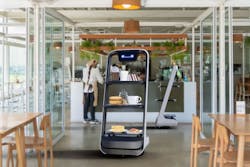The recent surge in the deployment of delivery robots has emerged as a solution to challenges such as labor shortages, rising wage costs, and the increasing demand for swift package deliveries. Within the realm of robotics, optics plays a pivotal role, particularly in the development of automated systems aimed at diminishing reliance on human intervention. A notable example is the rise of food delivery robots, utilizing an array of optical instruments to proficiently collect visual data, understand their surroundings, and execute intricate tasks. This prompts an exploration of the common optical tools employed in the domain of delivery robots.
At the core of delivery robot technology is the seamless integration of advanced systems and components, providing these robots with the capability to operate autonomously and execute precise delivery missions. The fundamental technologies that empower delivery robots include:
- Navigation and Localization: Accurate navigation is crucial for delivery robots. They employ cutting-edge technologies such as GPS, SLAM, LIDAR, and computer vision to map their surroundings, chart optimal routes, and determine their precise locations in real-time.
- Obstacle Detection and Avoidance: To ensure safe navigation, delivery robots must detect and navigate around obstacles. Sensors like cameras, ultrasonic devices, and LIDAR systems enable them to identify obstacles and plan alternative routes.
To implement these technologies, various components and assemblies are integrated into the robots:
- Image Sensor Efficacy: CMOS and CCD sensors facilitate the transformation of captured light into digital imagery, catering to the intricate tasks demanded of food delivery robots.
- Selective Filtering: Filters, with the ability to selectively transmit or block light within specific wavelength ranges, are integral to optical systems, enhancing their functionality in various scenarios.
- Precision Camera Technology: Cameras serve as the robotic “eyes,” capturing intricate imagery of their surroundings for tasks like identifying obstacles and pinpointing locations. Advanced optical designs, including aspherical and multifocal lenses, mitigate optical distortion and ensure high-quality images.
- Beam Splitting Proficiency: Beamsplitters divide incoming light into multiple trajectories, facilitating the simultaneous acquisition of multiple images. This strategy enhances the perceptual acumen of robots, allowing them to process visual data with heightened efficiency.
- Three-Dimensional Vision: Integrating 3D cameras with structured light or time-of-flight technology allows robots to acquire stereoscopic imagery and depth data. This, coupled with specialized optical elements, ensures precise depth information, enabling robots to discern object dimensions and execute nimble manipulation.
In summary, these optical systems are indispensable components of the robotic toolkit, equipping food delivery robots with the ability to perceive their surroundings comprehensively and execute tasks with precision. Enhanced by cutting-edge artificial intelligence, image processing algorithms, and machine learning, these optical marvels empower robots to extract and harness information for object recognition and manipulation, thereby addressing challenges posed by a shortage of human labor resources.
